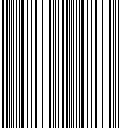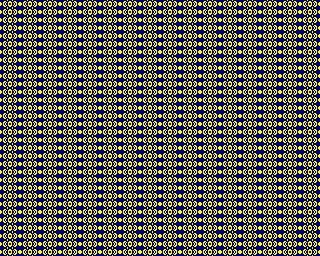This cache should be easier than my first puzzle cache.
I got the idea of encoding the coordinates in binary into a tiny image file and using it as the background on the cache page. I figured that binary coded decimal would be best.
My first test was something like this:

(Enlarged to show detail:)

When tiled, it looked like this:

I thought I could do better. For one thing, it was difficult keeping track of where the byte boundaries were, so I tried adding them, and came up with this:

Which, when tiled gave me:

Still not great. How about vertically? Nah. That'd just get me horizontal stripes.
Ooh! How about if I STACK the digits? Like so:
 Tiled:
Tiled: 
Now we're getting somewhere! How about some reflective symmetry?
 Which gave me:
Which gave me: 
Hey! I like it! ... Mikey likes it!
Now, all those images were done by encoding the posted coordinates. Here's how to decode the coordinates: Take a look at the black and white image above. In the fifth row, you have  , which consists of a black pixel, two white pixels and another black one. The white pixels represent the binary digit "0", and the black ones, "1". So this row represents the binary numeral 1001. (By the way, I chose row 5 only because it turns out to be more interesting to convert than the first row.)
, which consists of a black pixel, two white pixels and another black one. The white pixels represent the binary digit "0", and the black ones, "1". So this row represents the binary numeral 1001. (By the way, I chose row 5 only because it turns out to be more interesting to convert than the first row.)
Here's an easy way to convert a binary numeral to decimal: Start with the left-most digit, in this case "1", multiply by two, (the radix of the binary number system) and add the next digit, "0". (1×2+0=2.) Now multiply that number by two again, and add the next digit (2×2+0=4). Continue this process until you run out of digits. In this case, there's only one more digit (4×2+1=9), so  represents the decimal number 9. (This method works equally well for any base: Just multiply by the radix of the number system from which you're converting, instead of by two.)
represents the decimal number 9. (This method works equally well for any base: Just multiply by the radix of the number system from which you're converting, instead of by two.)
I know that on another recent puzzle cache, at least one of you learned how to save a background image so that you can manipulate it on your computer. But some of you may not have done that puzzle, and don't really want to learn how. So, to save you the trouble of saving the background image, and figuring out how to enlarge it, here is the background image for this cache page, already enlarged for you:

So, with all that information and these examples, I hope you will be able to tease the actual coordinates from the background image. (Don't forget that this image has reflective symmetry, so you want to convert only the upper left quadrant.)

Check your coordinates here.

or with certitude.
Epilog
In case you need more help, here's my phone number:

Post Script, 18 February, 2008
I just realized that, even though the cache description says that the samples encode the posted coordinates, that's not them! In actuality, they're the coordinates I was originally going to use for the posted coordinates before I moved them a few yards out towards the middle of the parking lot in an attempt to make it less likely that people going to the posted coordinates would disturb any landscaping. The final coordinates are actually nearly a mile away from the posted coordinates.
Post Post Script, 4 March, 2008
I fixed the images so that the original cache description is now correct (I think.) Please let me know if you detect any other problems.
Post Script #3, 15 August, 2008
Oh my! I don't know how it happened, but the phone number graphic was all messed up. Murmeltier had asked me if it were a joke. I assured him that it wasn't. ... And I thought I had double-checked it at the time.
Oh well. It's fixed now. (You may need to clear your browser cache for the correct image to appear.)
Sorry!